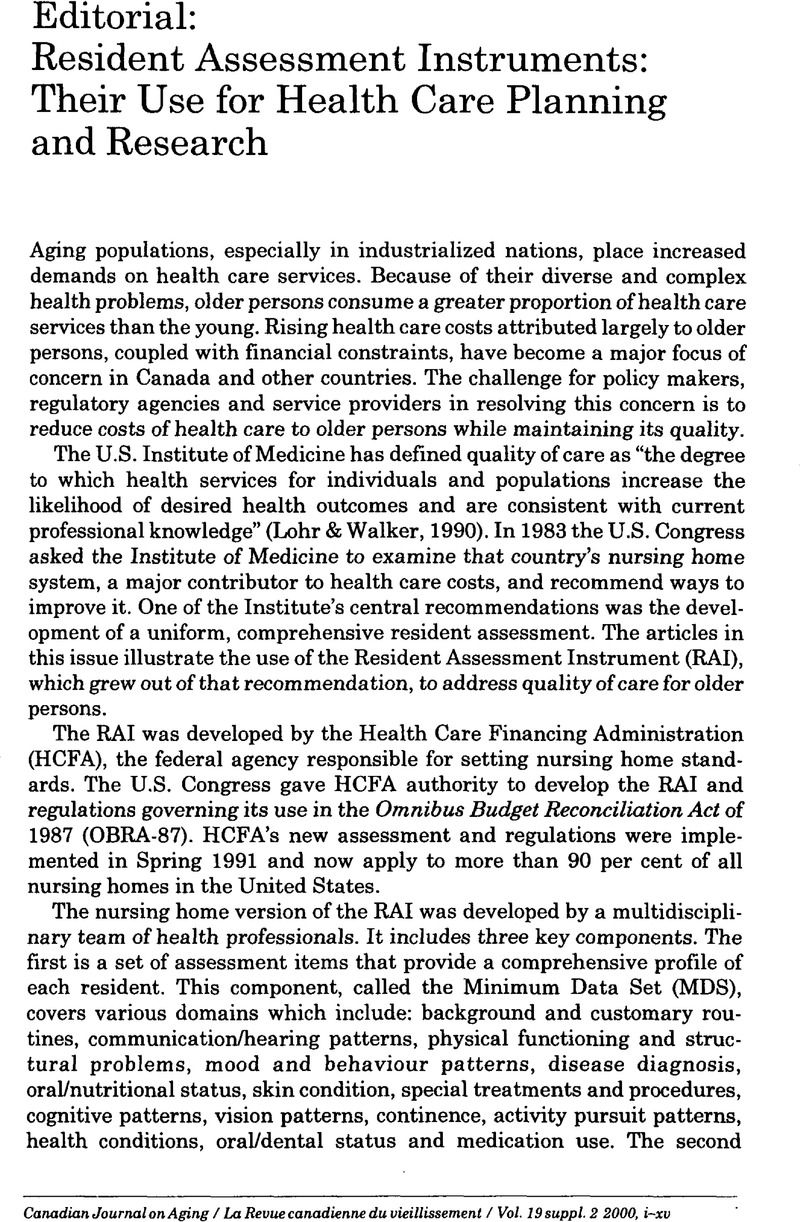No CrossRef data available.
Article contents
Editorial: Resident Assessment Instruments: Their Use for Health Care Planning and Research
Published online by Cambridge University Press: 29 November 2010
Abstract
An abstract is not available for this content so a preview has been provided. As you have access to this content, a full PDF is available via the ‘Save PDF’ action button.

- Type
- Editorial
- Information
- Canadian Journal on Aging / La Revue canadienne du vieillissement , Volume 19 , supplement S2 , Fall/Automne 2000 , pp. i - vii
- Copyright
- Copyright © Canadian Association on Gerontology 2000
References
Berlowitz, D.R., Ash, A.S., Brandeis, G.H., Brand, H.K, Halpern, J.L., & Moskowitz, M.A. (1996). Rating long term care facilities on pressure ulcer development: Importance of case-mix adjustment. Annals of Internal Medicine, 124, 557–563.CrossRefGoogle Scholar
Black, N. (1997). Developing high quality clinical databases. British Medical Journal, 315, 381–382.CrossRefGoogle ScholarPubMed
Gambassi, G., Landi, F., Peng, L., Brostrup-Jensen, C., Calore, K., Hiris, J., Lipsitz, L., Mor, V., & Bernabei, R. (1998). Validity of diagnostic and drug data on standardized nursing home resident assessments: Potential for geriatric pharmaco-epidemiology. Medical Care, 36, 22–34.CrossRefGoogle Scholar
Hawes, C, Phillips, CD., Mor, V., Fries, B.E., & Morris, J.N. (1992). MDS Data should be used for research. The Gerontologist, 32, 563–564.CrossRefGoogle Scholar
Lipstiz, L., Nakajima, I., Gagnon, M., Hirayama, T., Conelly, CM., & Izumo, H. (1994). Muscle strength and fall rates among residents of Japanese and American nursing homes: An international cross-cultural study. Journal of the American Geriatrics Society, 42, 953–959.CrossRefGoogle Scholar
Lohr, K.N., & Walker, A. J. (1990). The utilization and quality of control peer review organization. In Medicare: A strategy for quality assurance. Washington, DC: Institute of Medicine/National Academy Press.Google ScholarPubMed
Marek, K.D., Rantz, M.J., Fagin, CM., & Kreji, J.W. (1996). OBRA-87: Has it resulted in better quality of care? Journal of Gerontological Nursing, October, 28–36.CrossRefGoogle Scholar
Mor, V., Branco, K., Fleishman, J., Hawes, C., Phillips, C., Morris, J., & Fries, B. (1995). The structure of social engagement among nursing home residents. Journals of Gerontology: Psychological Sciences, 50, 1–8.CrossRefGoogle Scholar
Morris, J.N., Fries, B.E., Mehr, D.R., Hawes, C., Phillips, C., Mor, V., & Lipsitz, L. (1994). MDS cognitive performance scale. Journal of Gerontology: Medical Sciences, 49(4), M174-M182.CrossRefGoogle Scholar
Morris, J.N., Nonemaker, S., Murphy, K., Hawes, C, Fries, B.E., Mor, V., & Phillips, CD. (1997). A commitment to change: Revision of HCFA's RAI. Journal of American Geriatrics Society, 45, 1011–1016.CrossRefGoogle Scholar
Ouslander, J.G. (1994). Maximizing the Minimum Data Set. Journal of the American Geriatrics Society, 42, 1212–1213.CrossRefGoogle Scholar
Phillips, CD., Hawes, C, Morris, J., Mor, V., & Fries, B.E. (1996). Effects of the RAI on quality of care: Executive summary. Research Triangle Park, NC: Research Triangle Institute, Program on Aging and Long-Term Care.Google Scholar
Phillips, CD., & Morris, J.P (1998). The potential for using clinical and administrative data to analyze outcomes for the cognitively impaired: An Assessment of the Minimum Data Set for Nursing Homes. Alzheimer Disease and Associated Disorders, 11, 162–167.Google Scholar
Sgadari, A., Morris, J.N., Fries, B.E., Ljunggren, G., Jonsson, P.V., DuPaquier, J.-N., & Schroll, M. (1997). Efforts to establish the reliability of the RAI. Age and Ageing, 26(suppl. 2), 27–30.CrossRefGoogle Scholar
Teresi, J.A., & Holmes, D. (1992). Should MDS data be used for research? The Gerontologist, 32, 148–149.CrossRefGoogle Scholar


